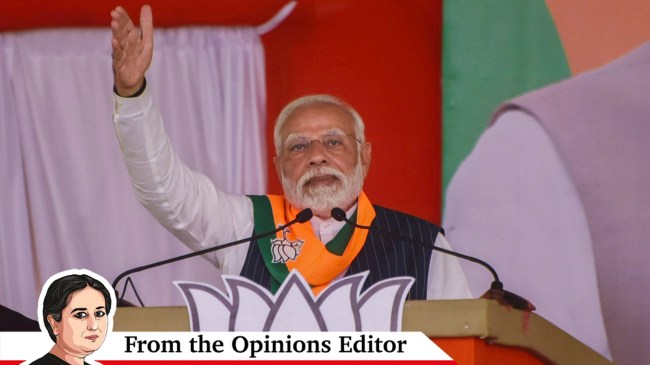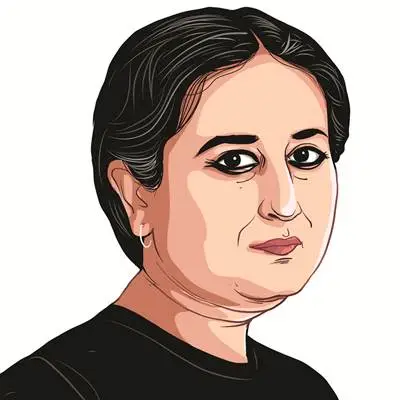Opinion Vandita Mishra writes: Beyond the election scoreboard, a BJP task, a Congress challenge
Some straws in the 2024 wind, irrespective of who wins and who loses on December 3
 The Modi-Shah high command is domineering and eager to remake the party at every level in its own image, and reluctant to decentralise power or encourage state BJP leaders who are not its creation or not beholden to it. (PTI)
The Modi-Shah high command is domineering and eager to remake the party at every level in its own image, and reluctant to decentralise power or encourage state BJP leaders who are not its creation or not beholden to it. (PTI) Dear Express Reader,
Results of the five assembly polls will come in next Sunday, and with a week to go, a reminder might be useful of some of the political things that will remain standing, irrespective of who wins and who loses.
By all accounts, at the national level, the Narendra Modi-led BJP has been adding layers to its appeal ever since its 2014 victory. But no matter what the final scoreboard says, this round of assembly elections points to at least one critical area of subtraction, and underlines a key BJP challenge: The agility and inventiveness that it has shown towards maintaining its dominance at the Centre is not matched in the states by the party. It is arguably an acknowledgement of this reality that has contributed to its strategy of making even the state election a referendum on the performance of the government led by Modi.
Of course, the apparent lag between a dexterous national BJP and a state BJP that is underperforming in comparison, or slower on the political uptake, may point to another syndrome of the Modi-BJP. The Modi-Shah high command is domineering and eager to remake the party at every level in its own image, and reluctant to decentralise power or encourage state BJP leaders who are not its creation or not beholden to it.
And yet, having said that, what is visible is this: Be it BJP-ruled Karnataka earlier in the year, or BJP-ruled MP in this round — both states that I travelled to and reported from — the BJP at state level has seemed vulnerable to perceptions of having reached a standstill. It has seemed more prone, therefore, to being overtaken by the yearning and demand for change, than the Modi government at the Centre, which still shows, after a nearly two-term incumbency, a remarkable capacity to project itself as an agent of change.
It may be more an optical illusion, and less reality, but the BJP at the Centre is able to convey to voters a sense of continuing forward movement, and to make them buy into it, in a way that its state governments are not able to (the MP result is still to come, but Karnataka voted out the BJP).
Most of all, at the Centre much more than in the state, the Modi-BJP has been able to tap into a need for a nation of the young in the throes of the social media revolution, to constantly pose and take selfies — to look good to itself and to flatter itself through its reflection in others’ eyes.
When PM Modi, in Bengaluru on Saturday, clad in an olive green G-suit, takes a sortie on Tejas, an indigenous version of light combat aircraft, and after the flight, posts on X: “Successfully completed a sortie… significantly bolstering my confidence in our country’s indigenous capabilities… a renewed sense of pride and optimism about our national potential”, and then leaves for Telangana to campaign ahead of the November 30 polls for the BJP — the sequence is choreographed and complete. It’s selfie politics, starring a leader, a nation and an election.
If the political battle is also a battle of imagination, then the state BJP lags behind the national BJP, and the Congress lags behind both.
For one, Congress could have used this round of state elections to frame a photo-op of its own — of Opposition unity.
Admittedly, the contest in three out of the five poll-bound states, MP, Rajasthan and Chhattisgarh, is mostly a straight fight between the Congress and BJP. And yet, it would have served the larger cause of a united Opposition, if not strictly the assembly poll calculus, to bring leaders of different parties together on the same stage, say, in a poll rally in MP.
That the Congress did not take the lead in doing so has meant that for the last couple of months or so, INDIA became an idea interrupted. Its constituents will now have to deal with the challenge, after its prolonged neglect during the assembly campaign, of putting it back on centrestage ahead of 2024.
More fundamentally, notwithstanding its wins and losses in this round of polls, Congress has to ask itself hard questions about whether it is engaging and persuading voters or only aspiring to become the receptacle for an impulse that is pro-change and/or anti-BJP.
From joining the BJP-led race of promises to put more cash in the pockets of voters here and now, to making a public show of Hindu religiosity, to refusing to share the frame with voters of the minority community, Congress has mostly tried to catch up with the BJP, or best it, by doing a BJP.
Just as it relegated its front with other Opposition parties, it also set aside its big idea in the campaign for this round of polls — the need for a caste census as a precursor to a fuller social justice, that Rahul Gandhi has talked up nationally.
The question for the Congress, at the end of these assembly elections, will be this: Is its best ambition and hope, at the Centre, as it seems to have been in the states, going to be that it is there to take advantage of the voters’ pivot away from the BJP? Or is it going to make a fight of it, take the initiative?
Till next week,
Vandita
Must Read Opinions From The Week:
– Sanjay Srivastava, “The forgotten citizens”, November 25
– Irfan Pathan, “The better team lost”, November 24
– Ian Healey, “The trophy was richly deserved’, November 24






